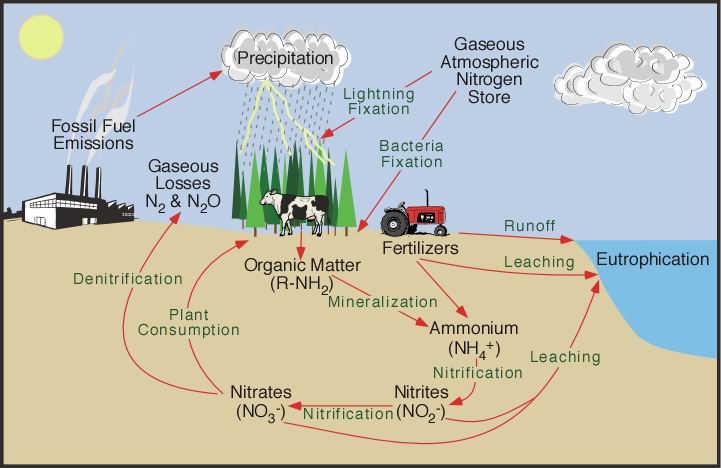Compost Applications for the Almond Orchard
Compost is applied by many growers as a supplement to their nutrient management program. Composts may contain nitrogen, phosphorous, potassium, and other micro-nutrients. Applications of compost also add organic matter, and the associated organic acids, which has been shown to increase soil tilth in cropping systems. Since all composts vary in nutrient content due to the variability in source material, nutrient benefits can only be determined through analysis.Nitrogen from Compost.To understand the effect of nitrogen from compost, we must first understand the nitrogen cycle. Organic matter contains nitrogen that is bound to various chemical compounds within the plant material. Termed organic nitrogen, it is unavailable to the plant. It can only be made available to the plant upon mineralization and conversion to nitrate through the process of nitrification. These processes are mediated by the soil microbial community. Once converted to nitrate, the nitrogen is available for plant use. Synthetic fertilizers go through similar processes depending upon their starting point (i.e. ammonium, nitrate, etc.).
 |
| Figure source: www.physicalgeography.net/fundamentals/9s.html |
Most finished composts vary from 0.5-2.5% total nitrogen. Since most of the nitrogen is held within plant compounds (organic form), not all of the nitrogen will be mineralized and available upon application. Research by Dr. Tim Hartz, UC Davis, has shown that most composts only release about 5-10% of the nitrogen in the nitrate form. Composts that have a lower carbon to nitrogen ratio release nitrate on the higher end of this range. Higher nitrogen containing composts (> 3% nitrogen) may release more than 10% of the nitrogen. Nitrogen benefits from compost also appear to be reduced in the following growing seasons, with very little mineralization occurring. At this point, it appears that the compost is simply organic matter.Phosphorus from Compost.Phosphorous (P) content within compost can be significant. Since exportation of P from the almond orchard is low (10-12 lbs P2O5/1000 kernel lbs), attention should paid to prevent over application of P. P is stored within organic and inorganic forms within compost and is readily available to the plant. Research has shown that it can substitute nearly 1:1 with synthetic fertilizer.Potassium from Compost.Compost can also contain high amounts of potassium (K). Since potassium is not incorporated into organic compounds within plants, it is readily available for plant use. Composts can serve as a alternative source of potassium, which is used at high rates within the almond orchard (90 lbs K2O/ 1000 kernel lbs).Micro-nutrients from compost.Micro-nutrients will vary in type, form, and amounts. Only an analysis will provide an estimate of the amounts contained within the applied compost. Although it is important to apply micro-nutrients, threshold within the soil is difficult to determine, thus recommendations on amounts are difficult.When applying compost, it is important to calculate the salt load that is also being applied. Many composts contain high amounts of sodium which may lead to sodium toxicity. In many cases, this prevents compost form being used as sole material applied within a nutrient management plan, but rather as a supplement used in concert with other nutrient sources.In sampling composts, what should I look for?For the most part, there are three groups of tests conducted to determine suitability of compost for agricultural purposes. The finish product should be tested for human pathogens/sanitary quality, for agricultural/nutrient value, and assessment of biological activity. Finally, as a grower, the economical cost of compost should be evaluated in order to determine if it fits within the orchard operation.Values for the above mentioned guidelines can be found at the Cal Recycle Website.How do I calculate nutrients applied from compost?Planned application is 5 tons/acre of dried compost containing 2% N, 2% P, and 2% K.Nitrogen:Follow the equation: tons applied x 2000 lbs/ton x % of nitrogen x 10% (nitrogen release)5 tons x 2000 lbs x 0.02 (% of nitrogen) x 0.1 = 20 lbs available for cropPhosphorous and potassium:Equation: tons applied x 2000 lbs/ton x % of Nutrient5 tons x 2000 lbs x 0.02 = 200 lbs of phosphorous (450 lbs P2O5 equivalent) and 200 lbs of potassium (250 K2O equivalent).
